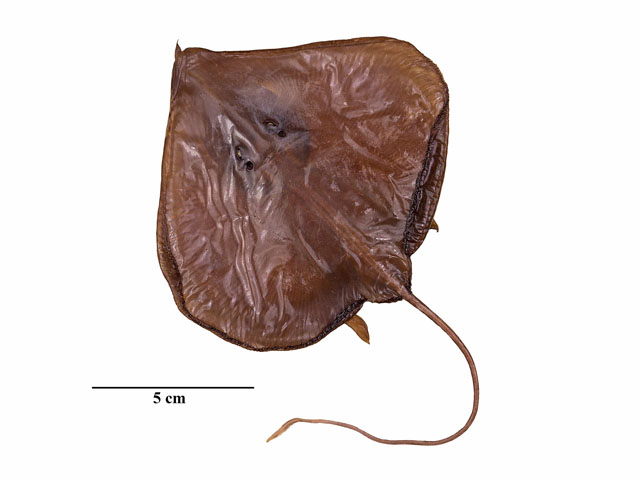| Anacanthobatidae (Smooth skates) |
| 42.9 cm TL (male/unsexed) |
|
bathydemersal; marine; depth range 1000 - 1725 m |
| Western Indian Ocean: off off Mozambique and Madagascar. |
|
This medium sized species grows to about 42.9 cm TL and has the following set of diagnostic characters: disc 0.9-1.1 times as wide as long and with rounded outer corners, it is extremely depressed pear-shaped to broadly inverse heart-shaped (in adult male); snout angle 85-106° and larger in juveniles; snout terminally expanded as a rostral lobe that is 9-12% of preorbital snout length; further juveniles with a short, thin rostral filament; narrow interorbital distance, 2-3% of TL; inner margin of posterior pelvic lobe fused along its entire length to root of tail; length of tail from mid-vent about equal to body length from tip of rostral lobe to mid-vent in adults, but 1.5 times body length in juveniles; surface of upper and lower disc and tail entirely naked except for 2 longitudinal rows of alar thorns in adult male; the tail with 2 lateral rows of fleshy, tubular papillae; colour of upper and lower surfaces dark grayish-brown, but ventral surface somewhat darker; upper jaw with 18=26 tooth rows; monospondylous vertebral centra 25-29; scapulocoracoid subrectangular, the rear corner sharply marked; large oval anterior fenestra no anterior bridge, one very large oval postdorsal and 5 minute to small postventral fenestrae; pelvic girdle with massive ischiopubic bar with straight to weakly concave anterior and deeply concave posterior contour; prepelvic processes are very long and inclined outwards, their length from axis of pelvic girdle maximal width 3.9-5.3 times median thickness of ischiopubic bar (Ref. 95335). |
| Found on the slope (Ref. 5578). Oviparous. Distinct pairing with embrace. Young may tend to follow large objects, such as their mother (Ref. 205). Eggs are oblong capsules with stiff pointed horns at the corners deposited in sandy or muddy flats (Ref. 205). Egg capsule measures 36.0 mm long and 19.0 mm wide (Ref. 41249). Taken only by deep-trawling research vessels (Ref. 5578). |
|
Least Concern (LC); Date assessed: 24 December 2018 Ref. (130435)
|
| harmless |
Source and more info: www.fishbase.org. For personal, classroom, and other internal use only. Not for publication.

